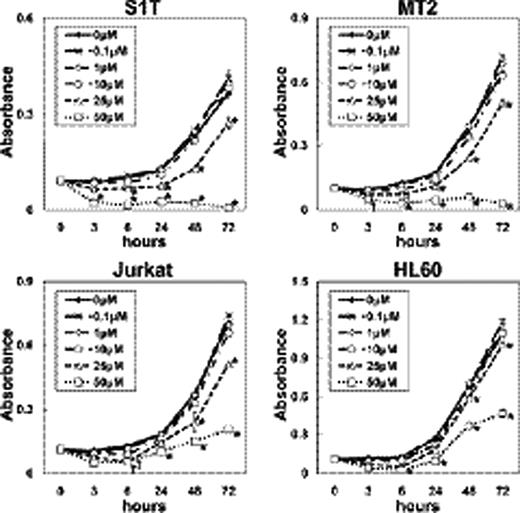Abstract
Abstract 2768
Adult T-cell leukemia-lymphoma (ATL) is an aggressive peripheral T-cell neoplasm developing after a long-term infection with human T-cell leukemia virus (HTLV-1), in which NF-kB is also implicated as an exacerbation factor. Despite recent progress in both chemotherapy and supportive care for hematological malignancies, the prognosis of ATL is still poor; overall survival at 3 years is only 24%. New strategies for the therapy and prophylaxis of ATL (e.g., vaccines and novel molecular target agents) are still required. SIRT1, an NAD+-dependent histone/protein deacetylase, plays a crucial role in various physiological processes, such as aging, metabolism, neurogenesis and apoptosis, due to its ability to deacetylate numerous substrates, such as histone and NF-kB. Here, we assessed how SIRT1 is regulated in primary ATL cells and leukemic cell lines. SIRT1 expression in ATL patients was significantly higher than that in healthy controls, especially in the acute type. Sirtinol, a SIRT1 inhibitor, induced significant growth inhibition or apoptosis in cells from ATL patients and leukemic cell lines, especially HTLV-1-related cell lines (S1T and MT-2). Sirtinol-induced apoptosis was mediated by activation of the caspase family, and inactivation of NF-kB, reducing IkBα phosphorylation. Interestingly, NAD+ augmented sirtinol-induced apoptosis following deacetylation of NF-kB via NAD+-dependent deacetylase. Thus, the SIRT1 inhibitor acted as a tumor suppressor, where NAD+ accelerated the SIRT1 inhibitor-induced apoptosis. These results suggest that SIRT1 is a crucial antiapoptotic molecule in ATL cells, and that SIRT1 inhibitors may be useful therapeutic agents for leukemia, especially in patients with ATL.
SIRT1 inhibitor reduces viability of leukemic cell lines. Cell lines were incubated at 1×105 cells/mL in the presence of various concentrations of sirtinol for 72 h. Proliferation of cell lines in the absence or presence of the indicated concentrations of sirtinol was assessed by WST-8 assay. Data are means ± S.D. from 3 independent experiments.
SIRT1 inhibitor reduces viability of leukemic cell lines. Cell lines were incubated at 1×105 cells/mL in the presence of various concentrations of sirtinol for 72 h. Proliferation of cell lines in the absence or presence of the indicated concentrations of sirtinol was assessed by WST-8 assay. Data are means ± S.D. from 3 independent experiments.
No relevant conflicts of interest to declare.
Author notes
Asterisk with author names denotes non-ASH members.


This feature is available to Subscribers Only
Sign In or Create an Account Close Modal